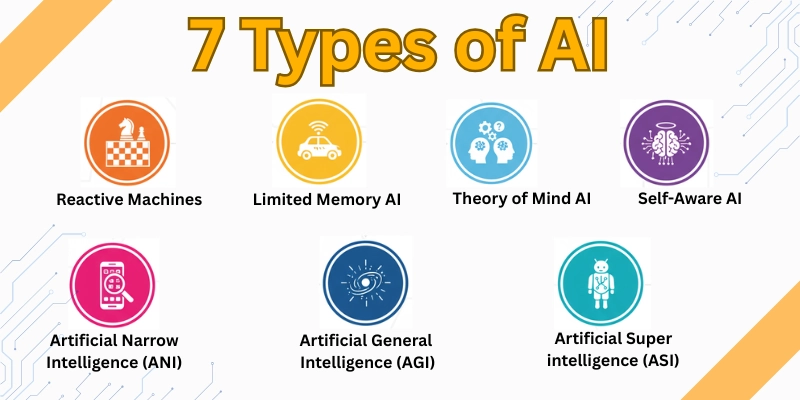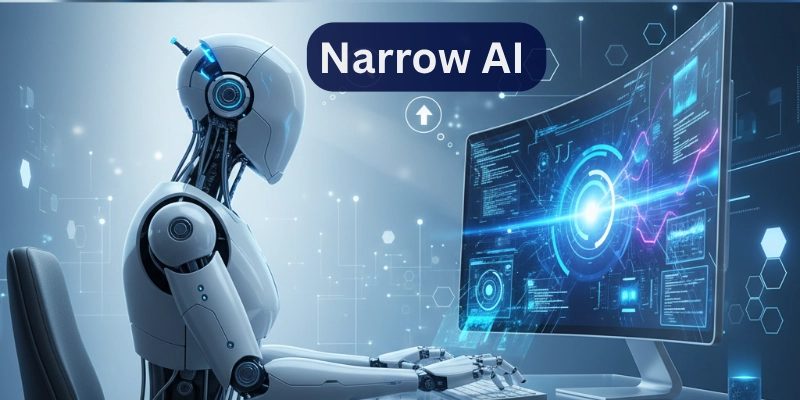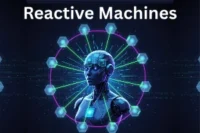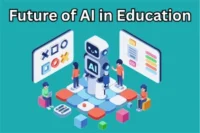7 Types of AI: Key Features, Uses, and Future Impact
Published: 28 Sep 2025
Each of the 7 Types of AI highlights the advancement of smart machines, each progressing step by step. There is a belief among many that AI is capable of thinking like a human, but the majority of it is still working through basic learning. AI is transforming our lifestyles and the way we work, from voice assistants like Alexa to cars that can drive themselves. But have you ever wondered how these different types of AI actually work in our daily lives?
Knowing the types discussed will allow you to see. What AI is already capable of and how it fits in within schools, hospitals, banks, and traveling down the road.
Understanding these types will give you a better idea of AI today and what AI might be capable of tomorrow.
What Are the 7 Types of AI?
The 7 Types of AI are the main groups that show how artificial intelligence grows from simple machines to smart systems that can learn and solve problems.

- Reactive Machines
- Limited Memory AI
- Theory of Mind AI
- Self-Aware AI
- Artificial Narrow Intelligence (ANI)
- Artificial General Intelligence (AGI)
- Artificial Superintelligence (ASI)
Without wasting time, let’s explain these types one by one in detail.
Reactive Machines
Reactive Machines is the simplest form of AI. It only thinks about what’s happening right now and can’t consider the past. They function like a quick calculator, they will compute the numbers correctly, and be fast, but won’t remember.
Example
A computer playing chess only thinks about the next move, or a basic voice assistant would only answer basic questions.
Applications
Reactive Machines are incorporated into many everyday tasks:
- Playing board games such as chess or checkers.
- Controlling traffic lights in congested cities.
- Simple customer service chatbots that will give pre-written responses.
- Basic factory robots to move or package objects.
- Basic smart technologies found in homes, such as smart thermostats.
Impact
These machines have many advantages:
- Complete simple tasks quickly and reduce errors.
- Allow people to save time by doing busy work routine tasks.
- Make games and entertainment more enjoyable and fair.
- Improve safety by controlling machines that require fast reactions.
- Reduce costs for simple tasks that don’t require human cognition.
Limited Memory AI
Limited Memory AI can apply past experiences to make more informed decisions and generate the ability to remember some past actions for a limited duration of time, which makes decisions smarter than simply reactive actions.
Example
Self-driving cars that gather recent traffic and road use information to account for the best next moves.
Applications
Limited Memory AI has practical uses in different ways in the world:
- The self-driving car’s speed and direction.
- Recommendations for online shopping based on past purchases.
- Fraud detection for banks based on recent transaction history.
- Smart assistants remember previous actions and preferences.
Impact
Limited Memory AI impacts life in terms of safety, efficiency, productivity, the economy, and daily life. It assists humanity:
- By making smarter decisions based on recent happenings.
- Creating a safer world through alerts to avoid accidents, etc.
- Saving time by predicting our needs based on previous actions.
- Reducing errors in tasks like e-commerce transactions.
Theory of Mind
Theory of Mind AI has advanced in its ability to understand human emotions, beliefs, and intentions, which aids its interactions with those humans.
Example
An example of a Theory of Mind AI would be an AI in customer support that changes its response based on how frustrated the user is.
Applications
The following are areas in which Theory of Mind AI can be applied:
- Virtual customer support AI that understands a user’s emotional condition,
- Healthcare assistants who recognize when patients are stressed or in discomfort,
- Interactive learning student tools that react to student feelings,
- Social robots that adjust their response to other human behaviors in real-time.
Impact on the world
Theory of Mind AI helps make human and AI interactions more intelligent in the following ways:
- They improve the communication abilities between humans and machines.
- They help response systems in mental health apps respond to emotions more accurately.
- They improve learning experiences for students.
- They allow for a more human-like experience when using AI tools in everyday tasks.
4. Self-Aware AI
Self-aware AI is the highest stage of AI development. These systems can not only acknowledge human emotions, but they can also understand who and what they are as a conscious entity.
Example of Self-Aware AI
A hypothesized robot that is capable of recognizing and understanding its own actions and decisions and making its own choices.
Self-Aware AI uses and applications
Self-Aware AI could be used in:
- More advanced robots as caregiving assistants in caregiving/patient situations.
- Autonomous and independent decision-making systems in industrial settings.
- Emotionally supportive robots that are self-aware of their own existence and the human brain.
- Complex simulations in researching humans or space travel.
Impact of self-aware AI
The industry would undergo revolutionary change:
- Machines could obtain independent thinking (freedom of thought).
- Making industries safer in critical thinking situations and recognizing possible errors.
- Robots in health care and other areas would have an emotional attachment and awareness.
- More ethical questions would need to be considered, like what rights do they have, and can we just shut them off?
5. Narrow AI (Weak AI)
Narrow AI is helping humans do a specific task better. It cannot perform tasks outside of this design.

Example
We use a voice assistant like Siri to answer questions instead of cooking for us or driving a car.
Applications
Narrow AI is the type of AI that we use most often in our day-to-day lives:
- Virtual assistants organize our schedules and set reminders.
- Recommendation engines generate suggestions based on our watch lists on streaming platforms.
- Spam filters in our email systems remove unwanted email and allow us to concentrate on what matters most.
- Fraud detection algorithms help to keep our banking systems and accounts safe.
Impact
Narrow AI improves efficiency in specific contexts:
- It saves time by allowing us to offload the repetitive tasks.
- It reduces human error in our narrow tasks.
- It helps services (digital) get smarter and provide better personalization.
- It assists businesses in making smart decisions for a narrow purpose or specific needs.
6. General AI (Strong AI)
General Artificial Intelligence represents the pinnacle of AI innovation, possessing the capability to perform any task that would otherwise require human intelligence. This creative and autonomous intelligence can learn a concept or information and apply that knowledge to not only the original field of knowledge but to any field.
Example
If a robot could teach math, drive a car, and create a work of art, this would be an example of general AI.
Applications
General AI could be utilized in areas such as:
- Research and development across many fields of study.
- Diagnosing and treatment decisions within healthcare systems.
- Educational platforms are creating customized lessons and applications.
- Autonomous systems relating to transportation and logistics.
Now the Implications
General AI could fundamentally disrupt various aspects of society by:
- Improving productivity across built environments and industries.
- Aiding in solving problems that traditional cognitive computing could not.
- Lessening reliance on humans to perform repetitive and mundane tasks or to do complex jobs.
- Creating ethical implications and maintaining control over intelligent systems.
7. Super AI (Artificial Superintelligence)
Super AI is more advanced than human intelligence, as it could actually outperform humans in everything from problem-solving to creativity.
Example
A hypothetical AI system that could create new technologies faster than humans.
Applications
- Super AI could transform many industries:
- Scientific research with super-fast processes for discovery.
- Exploring for and colonizing new planets.
- Advanced diagnostics and treatment in health care.
- Forecasting economic systems and global trends.
Impact
Super AI could have profound implications for society:
- Addressing problems too complex for humans alone.
- Increasing safety in society and increasing efficiencies.
- Raising important ethical and security questions.
- Radically altering jobs, the economy, and daily life.
Key Differences and Similarities
Understanding the key differences and similarities between the 7 types of AI helps you see how they work today and what the future might bring.
| Aspect | Details |
| Differences | Each AI type varies in how much it can learn, remember, and work without humans. Reactive Machines only react now, while Super AI is still just an idea. |
| Similarities | All aim to make tasks easier, save time, and help people make better decisions. |
| Today vs. Future | Artificial Narrow Intelligence (ANI) is in use today, like chatbots and voice assistants. Artificial General Intelligence (AGI) and Artificial Super Intelligence (ASI) are still future possibilities. |
Emerging Trends and Future Prospects
AI is growing fast, and many new changes are shaping its future. Here are some key trends to watch:
- Generative AI is rising: Tools that create images, music, or text are becoming more common.
- Ethical AI and privacy matter more: Companies are working harder to keep data safe and use AI responsibly.
- Emotion-aware AI research: Scientists are exploring AI that can understand and respond to human feelings.
- Global talks on AGI and ASI rules: Countries are discussing laws to guide the safe growth of advanced AI.
Potential Impact on Society and Industries
AI is changing how people work and live. Its growth can bring many good changes and also some challenges:
- Faster work: AI helps businesses finish tasks more quickly and with fewer mistakes.
- New jobs and skills: Technology creates roles for people who can work with AI tools.
- Better services: Healthcare, education, and transport can become more accurate and efficient.
- Need for rules: Governments must make clear laws to keep AI safe and fair for everyone.
Tips for Beginners
If you are a beginner to AI, start small and learn step by step. These simple tips can help beginners:

- Begin with basics: Read short guides or watch videos that explain AI in simple words.
- Try free courses: Platforms like Coursera or Khan Academy offer beginner AI lessons.
- Practice with tools: Use free AI tools or apps to see how they work in real life.
- Join a community: Take part in online groups or forums to ask questions and share ideas.
Conclusion
So, guys, in this article, we’ve covered 7 Types of AI in detail. I suggest you start by learning the basics and testing free tools like simple AI apps or learning platforms. As you grow more confident, explore more advanced AI ideas to see how they fit your career or studies. Remember, AI is powerful but works best when guided by human creativity and care. Take the first step today and explore the 7 Types of AI to unlock new skills and opportunities for the future.
FAQs
After learning about the 7 Types of AI, you might have some questions. Here are common FAQs with easy answers to help you understand better.
The 7 Types of AI are different levels of artificial intelligence, from the simplest machines to the most advanced ideas. They include Reactive Machines, Limited Memory, Theory of Mind, Self-Aware AI, Artificial Narrow Intelligence (ANI), Artificial General Intelligence (AGI), and Artificial Superintelligence (ASI). Each type shows how AI can grow from doing basic tasks to thinking almost like humans.
Right now, we mostly use Artificial Narrow Intelligence (ANI). This type focuses on a single job, such as chatbots, voice assistants, or recommendation systems. It helps in everyday life without trying to think like a human.
Not yet. Theory of Mind and Self-Aware AI describe AI that can understand feelings or even have self-awareness, but these ideas are still in research. Today’s AI can copy human conversation but it does not truly feel emotions.
AI supports many fields such as healthcare, education, finance, and transport. For example, ANI helps doctors read X-rays, improves online learning, and powers self-driving cars. Each type brings new ways to save time and improve results.
AI might replace some simple or repetitive jobs, but it will also create new roles that need human creativity and decision-making. People will still be important for tasks that require empathy and complex problem-solving. Learning about AI can help you stay ready for these changes.
Yes, when used carefully. It’s important to protect personal data and follow rules for privacy and security. Schools, companies, and parents should guide how AI tools are used to keep everyone safe.
Begin with free online lessons, videos, or simple AI apps to see how they work. Try small projects like using a chatbot or testing a basic AI tool. Learning step by step will make the topic easy and fun.
Artificial General Intelligence (AGI) is AI that could think and learn like a human. Artificial Superintelligence (ASI) would go beyond human thinking and be far more powerful. AGI is still a plan for the future, while ASI is only an idea right now.
Ethical AI means using AI in a fair and responsible way. It protects people’s privacy and prevents unfair decisions. Without ethics, AI could harm trust and create problems in society.
AI can give each student lessons that match their speed and style. It may help teachers check homework faster and guide students who need extra support. This makes learning easier and more personal for everyone.

- Be Respectful
- Stay Relevant
- Stay Positive
- True Feedback
- Encourage Discussion
- Avoid Spamming
- No Fake News
- Don't Copy-Paste
- No Personal Attacks

- Be Respectful
- Stay Relevant
- Stay Positive
- True Feedback
- Encourage Discussion
- Avoid Spamming
- No Fake News
- Don't Copy-Paste
- No Personal Attacks





